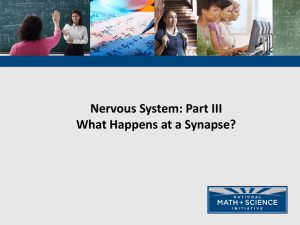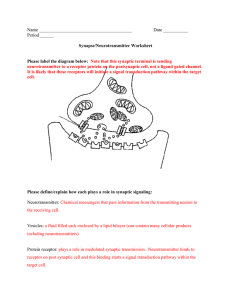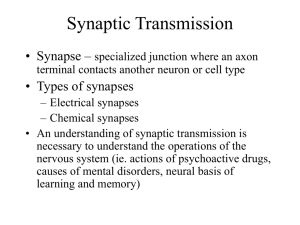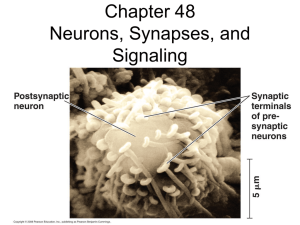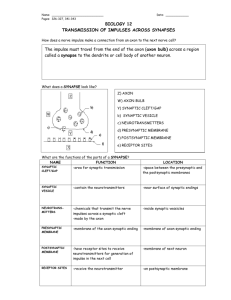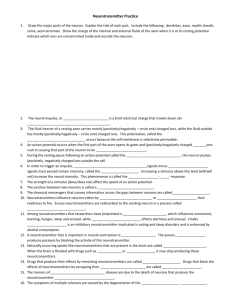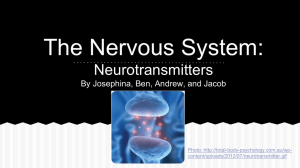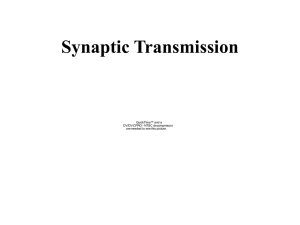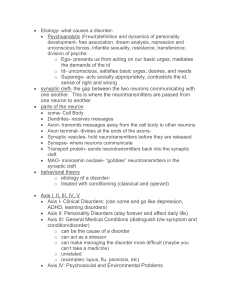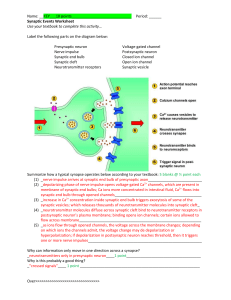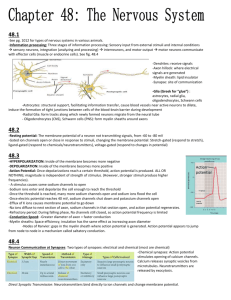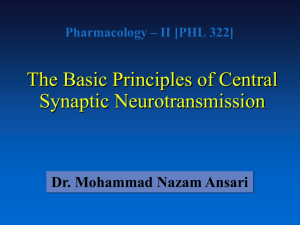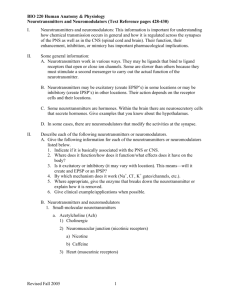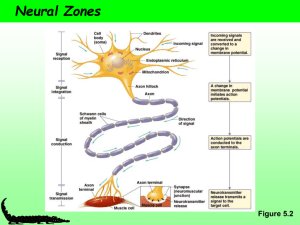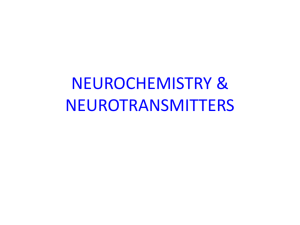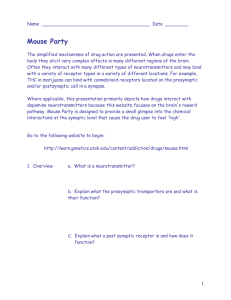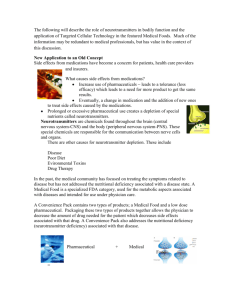NEUROTRANSMITTERS
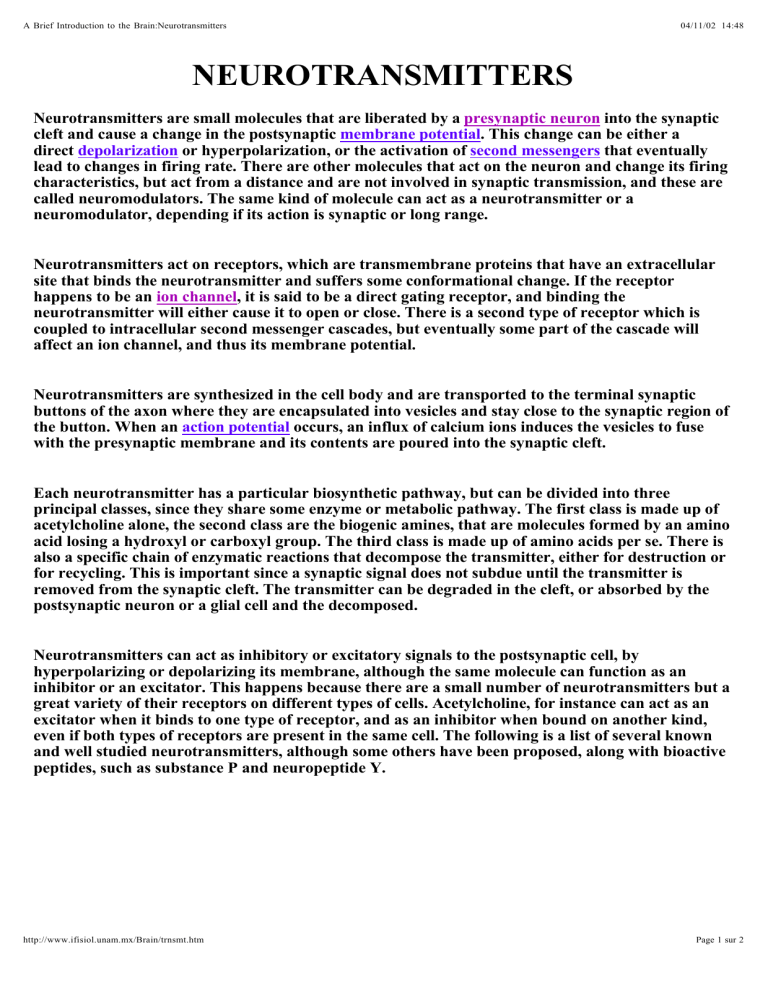
A Brief Introduction to the Brain:Neurotransmitters 04/11/02 14:48
NEUROTRANSMITTERS
Neurotransmitters are small molecules that are liberated by a cleft and cause a change in the postsynaptic direct depolarization presynaptic neuron membrane potential
or hyperpolarization, or the activation of
into the synaptic
. This change can be either a second messengers characteristics, but act from a distance and are not involved in synaptic transmission, and these are called neuromodulators. The same kind of molecule can act as a neurotransmitter or a neuromodulator, depending if its action is synaptic or long range.
that eventually lead to changes in firing rate. There are other molecules that act on the neuron and change its firing
Neurotransmitters act on receptors, which are transmembrane proteins that have an extracellular site that binds the neurotransmitter and suffers some conformational change. If the receptor happens to be an ion channel , it is said to be a direct gating receptor, and binding the neurotransmitter will either cause it to open or close. There is a second type of receptor which is coupled to intracellular second messenger cascades, but eventually some part of the cascade will affect an ion channel, and thus its membrane potential.
Neurotransmitters are synthesized in the cell body and are transported to the terminal synaptic buttons of the axon where they are encapsulated into vesicles and stay close to the synaptic region of the button. When an action potential occurs, an influx of calcium ions induces the vesicles to fuse with the presynaptic membrane and its contents are poured into the synaptic cleft.
Each neurotransmitter has a particular biosynthetic pathway, but can be divided into three principal classes, since they share some enzyme or metabolic pathway. The first class is made up of acetylcholine alone, the second class are the biogenic amines, that are molecules formed by an amino acid losing a hydroxyl or carboxyl group. The third class is made up of amino acids per se. There is also a specific chain of enzymatic reactions that decompose the transmitter, either for destruction or for recycling. This is important since a synaptic signal does not subdue until the transmitter is removed from the synaptic cleft. The transmitter can be degraded in the cleft, or absorbed by the postsynaptic neuron or a glial cell and the decomposed.
Neurotransmitters can act as inhibitory or excitatory signals to the postsynaptic cell, by hyperpolarizing or depolarizing its membrane, although the same molecule can function as an inhibitor or an excitator. This happens because there are a small number of neurotransmitters but a great variety of their receptors on different types of cells. Acetylcholine, for instance can act as an excitator when it binds to one type of receptor, and as an inhibitor when bound on another kind, even if both types of receptors are present in the same cell. The following is a list of several known and well studied neurotransmitters, although some others have been proposed, along with bioactive peptides, such as substance P and neuropeptide Y.
http://www.ifisiol.unam.mx/Brain/trnsmt.htm
Page 1 sur 2
A Brief Introduction to the Brain:Neurotransmitters 04/11/02 14:48
Neurotransmitter: Function: Synthesis by (enzymes):
Acetylcholine
Bioactive amines:
Dopamine
Epinephrine
Norepinephrine
Serotonin
Amino acids:
Glutamate
Glycine mostly excitatory Choline acetyltransferase exitatory and inhibitory Tyrosine hydroxilase exitatory Tyrosine hydroxilase and dopamine-b-hydroxilase exitatory exitatory exitatory mostly inhibitory g-Aminobutiric acid (GABA) inhibitor
Tyrosine hydroxilase and dopamine-b-hydroxilase
Tryptophan hydroxilase
Metabolic amino acid
Metabolic amino acid
Glutamate descarboxilase
Go to the list of topics http://www.ifisiol.unam.mx/Brain/trnsmt.htm
Page 2 sur 2


